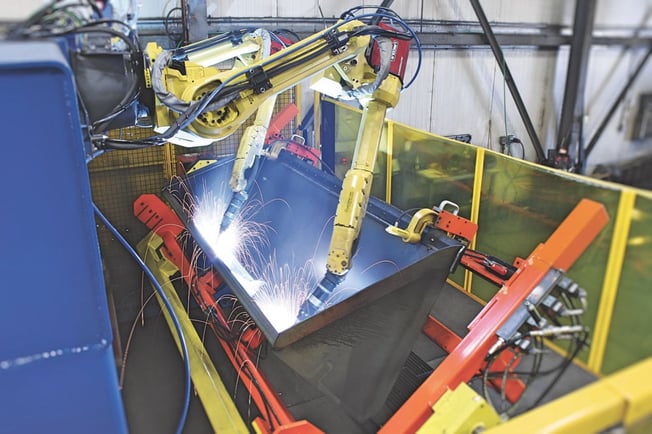Over the past few years, we’ve increased our investment in robotic welding. Now, if you were to see Virnig Manufacturing’s shop floor, you’d see a mixture of skilled welders and robotic welding working together to manufacture skid steer attachments. And over the years, we’ve found that robotic welding improves efficiency, quality, and consistency for product manufacturing.
The Costs and Benefits of Robotic Welding
 When they hear about robotics in the manufacturing field, most people will associate it with increased equipment costs. And up front, they have a point. Robotic welding isn’t cheap, but it's an investment. It’s an investment in your products, your process, and your people. And in our experience, the equipment pays for itself in about 1.5 years.
When they hear about robotics in the manufacturing field, most people will associate it with increased equipment costs. And up front, they have a point. Robotic welding isn’t cheap, but it's an investment. It’s an investment in your products, your process, and your people. And in our experience, the equipment pays for itself in about 1.5 years.
Product Quality
The use of robotic welding reduces spatter and discoloration during the manufacturing process. Plus, the end products require less deburring. This adds ease to the manufacturing process and helps us create a higher-quality final product.
Production Speed
Robotic welding increases weld speed without compromising precision. Robots excel at performing redundant tasks without fatigue or error. We’ve found robotic welding to be the answer to the more tedious welding tasks that can annoy skilled and experienced welders. Automation in this area also increases output and shortens lead time.
Employee Opportunity
Some of our welders have the opportunity to work with the robotic welding equipment while still welding manually. As a result, these welders are able to grow their skills in multiple ways. We've found that by investing in robotic welding, we're able to more easily fill welding positions and retain our skilled employees.
Employee Safety
There’s no doubt about it, manual welding is hazardous work. Robotic welding allows us to increase the level of safety on our shop floors because we never want any of our employees to be injured. Plus, by increasing the level of safety for welders, robotic welding can actually increase the appeal of manufacturing work. After all, these machines don't eliminate the need for skilled welders. Instead, they add a layer of security to their careers.
Overall, we’ve found that the efficiencies gained through robotic welding not only make up for the initial cost but have an ongoing cost-reduction benefit over time.

